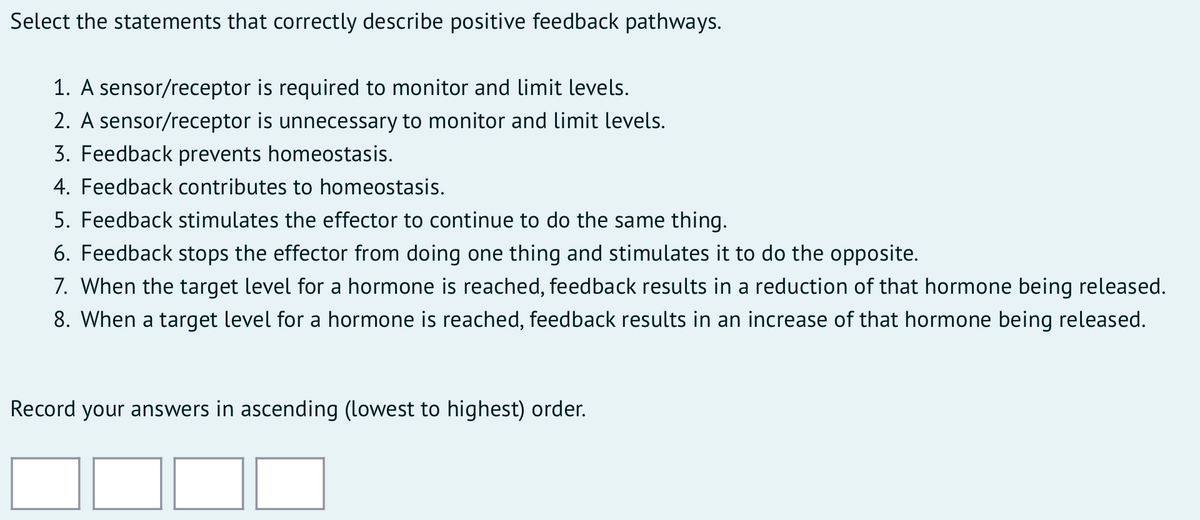Select the statements that correctly describe positive feedback pathways. 1. A sensor/receptor is required to monitor and limit levels. 2. A sensor/receptor is unnecessary to monitor and limit levels. 3. Feedback prevents homeostasis. 4. Feedback contributes to homeostasis. 5. Feedback stimulates the effector to continue to do the same thing. 6. Feedback stops the effector from doing one thing and stimulates it to do the opposite. 7. When the target level for a hormone is reached, feedback results in a reduction of that hormone being released. 8. When a target level for a hormone is reached, feedback results in an increase of that hormone being released. Record your answers in ascending (lowest to highest) order.
Select the statements that correctly describe positive feedback pathways. 1. A sensor/receptor is required to monitor and limit levels. 2. A sensor/receptor is unnecessary to monitor and limit levels. 3. Feedback prevents homeostasis. 4. Feedback contributes to homeostasis. 5. Feedback stimulates the effector to continue to do the same thing. 6. Feedback stops the effector from doing one thing and stimulates it to do the opposite. 7. When the target level for a hormone is reached, feedback results in a reduction of that hormone being released. 8. When a target level for a hormone is reached, feedback results in an increase of that hormone being released. Record your answers in ascending (lowest to highest) order.
Human Anatomy & Physiology (11th Edition)
11th Edition
ISBN:9780134580999
Author:Elaine N. Marieb, Katja N. Hoehn
Publisher:Elaine N. Marieb, Katja N. Hoehn
Chapter1: The Human Body: An Orientation
Section: Chapter Questions
Problem 1RQ: The correct sequence of levels forming the structural hierarchy is A. (a) organ, organ system,...
Related questions
Question

Transcribed Image Text:Select the statements that correctly describe positive feedback pathways.
1. A sensor/receptor is required to monitor and limit levels.
2. A sensor/receptor is unnecessary to monitor and limit levels.
3. Feedback prevents homeostasis.
4. Feedback contributes to homeostasis.
5. Feedback stimulates the effector to continue to do the same thing.
6. Feedback stops the effector from doing one thing and stimulates it to do the opposite.
7. When the target level for a hormone is reached, feedback results in a reduction of that hormone being released.
8. When a target level for a hormone is reached, feedback results in an increase of that hormone being released.
Record your answers in ascending (lowest to highest) order.
Expert Solution
This question has been solved!
Explore an expertly crafted, step-by-step solution for a thorough understanding of key concepts.
This is a popular solution!
Trending now
This is a popular solution!
Step by step
Solved in 2 steps

Recommended textbooks for you

Human Anatomy & Physiology (11th Edition)
Anatomy and Physiology
ISBN:
9780134580999
Author:
Elaine N. Marieb, Katja N. Hoehn
Publisher:
PEARSON

Anatomy & Physiology
Anatomy and Physiology
ISBN:
9781259398629
Author:
McKinley, Michael P., O'loughlin, Valerie Dean, Bidle, Theresa Stouter
Publisher:
Mcgraw Hill Education,

Human Anatomy
Anatomy and Physiology
ISBN:
9780135168059
Author:
Marieb, Elaine Nicpon, Brady, Patricia, Mallatt, Jon
Publisher:
Pearson Education, Inc.,

Human Anatomy & Physiology (11th Edition)
Anatomy and Physiology
ISBN:
9780134580999
Author:
Elaine N. Marieb, Katja N. Hoehn
Publisher:
PEARSON

Anatomy & Physiology
Anatomy and Physiology
ISBN:
9781259398629
Author:
McKinley, Michael P., O'loughlin, Valerie Dean, Bidle, Theresa Stouter
Publisher:
Mcgraw Hill Education,

Human Anatomy
Anatomy and Physiology
ISBN:
9780135168059
Author:
Marieb, Elaine Nicpon, Brady, Patricia, Mallatt, Jon
Publisher:
Pearson Education, Inc.,

Anatomy & Physiology: An Integrative Approach
Anatomy and Physiology
ISBN:
9780078024283
Author:
Michael McKinley Dr., Valerie O'Loughlin, Theresa Bidle
Publisher:
McGraw-Hill Education

Human Anatomy & Physiology (Marieb, Human Anatomy…
Anatomy and Physiology
ISBN:
9780321927040
Author:
Elaine N. Marieb, Katja Hoehn
Publisher:
PEARSON